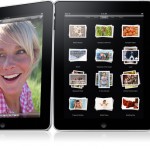iPad
News, Opinion Last week, Apple introduced its much-anticipated tablet, the iPad. There was plenty of speculation before the fact of what it might be, but much of it turned out to be just that. Here is a brief rundown of what it is and, perhaps more importantly, what it isn’t.
Last week, Apple introduced its much-anticipated tablet, the iPad. There was plenty of speculation before the fact of what it might be, but much of it turned out to be just that. Here is a brief rundown of what it is and, perhaps more importantly, what it isn’t.
What It Is
Think of the iPad as a larger iPhone, or iPod Touch, that can’t make phone calls. It uses the same OS as those devices and connects to the Internet via an available WiFi signal, and some models can connect to via 3G with an extra data plan from AT&T that that runs either $15 or $30 per month depending on how much capacity you need. The price range of the iPad is $500 – $830.
With a 9.7 inch screen, weighing 1.5 pounds at a half-inch thick, the unit is designed to compete with the Kindle from Amazon in that it will let you read complete books that you can purchase online, but it does much more than that. Because this is a full-color device that lets you add applications, the comparison does not do either device justice.
Beyond the same capabilities and apps you’d find on the iPhone and iPod Touch, there will be some newer applications that will take advantage of the larger screen (like the new MLB app that was showcased during the keynote address, for example), and add capabilities that will make it more like a laptop. To that end, Apple has introduced iWork for the iPad which will let you edit documents, spreadsheets and presentations. All of these apps (Pages, Numbers and Keynote) are sold separately and you can get one or more individually or as a package.
It’s important to note that, like the iPhone and iPod Touch, the keyboard is on-screen. Because it’s larger, I’d imagine it’s easier to use, but only actual experience will tell us whether you could really sit down and easily write a term paper or edit a spreadsheet on it.
What It Isn’t
The iPad is not a traditional laptop, nor do I see it replacing a laptop for professionals any time soon. But it might be a good alternative for those whose needs are limited to e-mail, web-surfing and simple documents, all while playing your favorite tunes. With a reported 10-hour battery life (your mileage will vary, I’m sure) it might be a good fit for frequent flyers too.
Like its older siblings, the iPad does not multitask, which means that you cannot run programs in the background. Normally, since most apps return you to the screen you had been looking at when you exited them, this doesn’t make too much of a difference, but in some cases it will. For example, I have an app called AirFoil Speakers that lets me listen to sounds broadcast by my desktop computer, but only when that app is in the foreground. If I switch to another app like Safari, the sound is lost and I have to go back to AirFoil Speakers to get it back.
It isn’t really a communication device beyond e-mail, text messages, and the like. You can’t make a phone call with it, and there is no video camera for video chats, although that seems a natural evolution.
The other thing it isn’t is here yet. Apple will be shipping the first models in 60 days or so.
Conclusion
I’m sure there will be a market for this device, but I just don’t know if it will sell as well as Apple hopes. Most of the things it can do can be done on an iPhone or iPod Touch, both of which are smaller and lighter, or on a regular laptop that is heavier, to be sure, but also more powerful. The market will be people who want the larger screen while on the road for watching movies or reading books without the additional weight of a traditional laptop. If that’s you, go take a look once it arrives at the Apple Stores.
Then, after you’ve looked, go home and read a book or watch TV because, as with all new technology, you do not want to be the one testing the first version of any device, even one with the potential coolness factor of the iPad.
